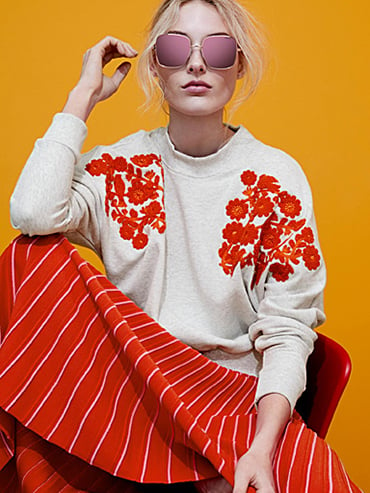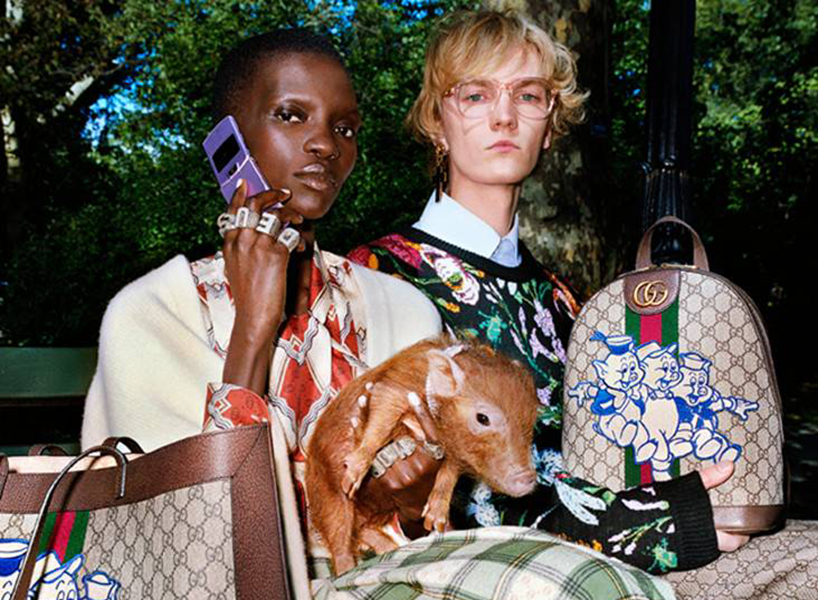I’m Sick of Retailers Capitalizing on Chinese New Year
Seriously, who needs a 120-piece collection of Chinese New Year merch?


While walking down Bloor Street in Toronto recently, I noticed a common theme in the luxury store windows: red and gold merchandise, images of pigs and big lettering spelling out “HAPPY CHINESE NEW YEAR” both in English and Chinese.
The commodification of Lunar New Year isn’t anything new, but it has definitely become more and more popular among western retailers over the past few years. And the bottom line is pretty clear: These products cater to an extremely lucrative market, the Chinese. According to a recent study by Bain consultancy, Chinese shoppers are responsible for a third of all luxury shopping around the globe, spending over $7 billion each year on luxury goods. They’ve been described as the “most important,” “smartest” and “brand-conscious” consumers “anywhere in the world.” It’s no wonder every brand seems to be jumping on the Chinese New Year bandwagon under the guise of “honouring” the cultural celebration.
Just a few of the Chinese New Year offerings you can find this year: In the luxury realm, there’s Gucci’s 35-piece New Year range featuring Disney’s “Three Little Pigs” and Dolce & Gabbana’s men’s T-shirts and sweatshirts, also with prints of cartoon pigs—a bold and surprising move, especially after the brand’s disastrous “D&G Loves China” campaign, which resulted in a boycott of the brand both online and offline in China. In the fast fashion world, there’s H&M’s excessive 120-piece Lunar New Year Collection (seriously, who needs 120 pieces of CNY gear?), complete with an ad campaign starring Chinese celebrities such as Ma Sichun, Jiang Wenli, Yuan Hong and Zhang Xinyi. At least they used actual Chinese models, unlike Canadian retailer Simons, which is facing online criticism for its very white campaign.
Hey @simons, why are there only white people celebrating lunar new year in your email? Another question: why are there only white people in your email? Unsubscribing pic.twitter.com/4FwnjFyPM1
— Linda (@chkn_nguyen) February 5, 2019
And then there’s Aldo’s Lunar New Year collection, which it describes as a“spirited” collection of shoes and accessories, including red and black footwear, furry pig keychains and handbags with knot accents meant to pay homage to the Chinese artform that originated as a method for communication and recording historical events. Talk about appropriation. In the beauty category, Sephora is selling Lunar New Year gift sets and products (the majority of which are from non-Chinese beauty brands) and offering promos surrounding the lucky number 8, Dyson is offering a limited-edition red Supersonic hair dryer with a gold presentation case and M.A.C Cosmetics has a “Lucky Red” collection for the occasion. Whew.
I’ll admit—in the past, I thought it was nice to have a cultural holiday that my family celebrates acknowledged by these big retailers. Heck, I even created roundups of these types of Chinese New Year products back in my days as a fashion and beauty editor. I think the lack of representation of Asians in media made me long for products that were catered to me and my Chinese heritage. But now, seeing these brands attempting to appeal to the Chinese market doesn’t sit well with me. After all, they’re not Asian brands and their half-hearted attempts to lure Chinese customers into their stores seem desperate at best. Am I really expected to believe these American and European brands truly appreciate the meaning of Chinese New Year when the majority of them can’t even hire Chinese artists to design and produce these products, and are literally appropriating ancient artforms rich in symbolic meaning? This type of Lunar New Year merch no longer makes me feel as though my culture is being acknowledged—it makes me feel like it’s being exploited for money. And that’s a problem.
As for whether that lucrative Chinese market is really buying this merch, that’s hard to tell. Retail and consumer goods consulting firm Strategic Resource Group told CGTN America last year that the amount Chinese consumers spend on Lunar New Year tends to go up at least 11–12% per year, but it’s unclear whether this money is spent on products. And Retail analytics company Edited says Chinese New Year merchandise sell-outs increased by 675% in 2018 compared to 2017. There is no demographic breakdown of who is actually buying these products, but clearly, some people are.
Interestingly, the cultural interpretation of these products does seem to have an impact on whether they are successful, with many Chinese consumers publicly calling out brands on their failed attempts to celebrate the holiday. Earlier this year, Burberry released its first-ever Lunar New Year ad on Chinese social media app, WeChat. However, the ad, which resembled a somber-looking family portrait, was criticized for being “creepy,” and for misinterpreting the festive nature of the holiday.
A short while later, Bvlgari found itself in the middle of a wordplay controversy when it released its Chinese New Year ad on WeChat and accidentally linked Jewish culture with pigs to welcome the new year. Brief explainer: In Mandarin, the word “pig” is pronounced “zhu” which is similar to the pronunciation of Jew in English. The Bvlgari campaign headline meant to say, “Be my bright pig in the palm,” a punny way to showcase its jewellery and watches, but instead it directly translated to “Be my bright JEW in the palm.” Both Burberry and Bvlgari swiftly removed their campaigns from the app, and for good reason. Again, just look to Dolce & Gabbana for proof of what can happen to a luxury brand when they piss off the Chinese.
And it’s not just Chinese consumers taking issue with New Year merchandise—Chinese-Canadians are unhappy, too. When I tweeted out my annoyance over the commercialization of Chinese New Year, other Chinese-Canadians expressed they felt the same. One person described the commodification as an “exploitative and disingenuous practice,” while another said it came across as simply a “great profit opportunity.” Clearly, I wasn’t the only one who felt like my cultural traditions were being used to generate sales, rather than being honoured and celebrated as these retailers would like us to believe.
However, another user (who identifies culturally as Jewish) didn’t see it as problematic and suggested it was simply an opportunity to share one’s culture. He tweeted, “There is nothing inappropriate or unkowledgable [sic] about marketing during holidays and directing the marketing towards the culture that celebrates the holiday.”
Say it with me: It is not okay for anyone to think that using someone else’s culture for profit is okay.
Also, don’t tell someone from another culture/race how to feel when their culture is being exploited.
Are we done with POCs being talked down to?
— Jane Man (@janeccman) January 22, 2019
Relegating a meaningful celebration to gimmicky products (most of which I can’t even afford!) is not cool. Using colours, symbols and imagery from my culture is not sharing, it’s appropriation. All of it is problematic. And no one has the right to tell me, or other POC, how we can feel about our cultural traditions being manipulated for profit.








